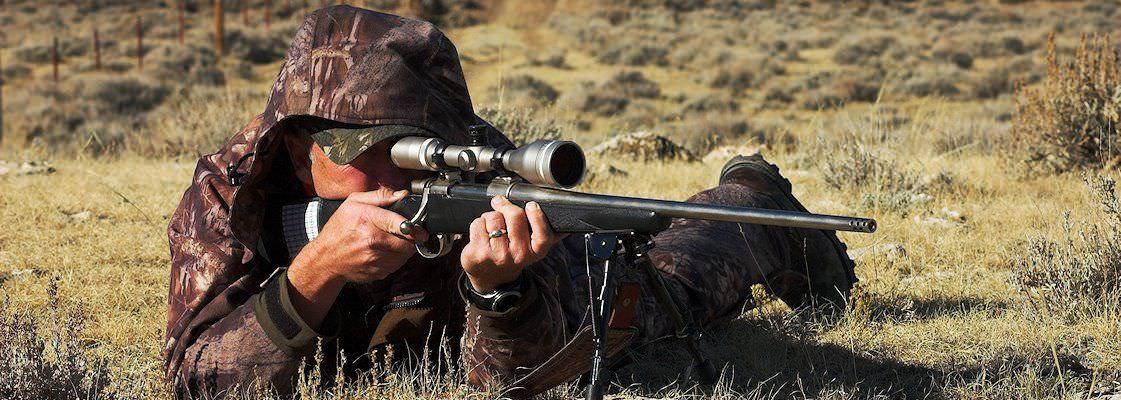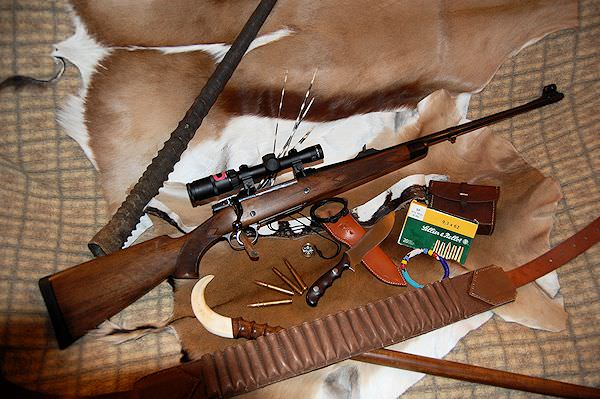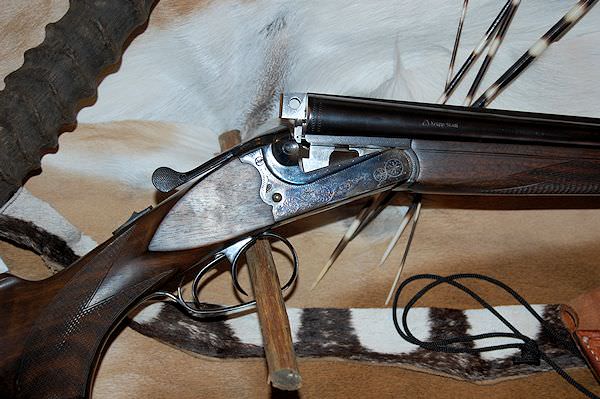AS Hunting Adventures has been conducting rifle hunting safaris in South Africa, Zimbabwe and Namibia since 1998.

Rifle hunting is certainly the most popular method employed on hunting safaris in Southern Africa. The question of which caliber is best and which rifle to bring on safari can be a topic of endless discussion. Experienced hunters and Professional Hunters alike will surely have their favorites and are more than willing to discuss the subject.
The right rifle will, in many instances, largely depend on the bag of trophies you are interested in taking. The “old timers” are still “locking horns” over the pros and cons of the .375 H&H versus the 9.3 X 62 and that debate is sure to go on until the last impala is in the salt. One bottom line here; if it is dangerous game that you are after, the .375 caliber is the minimum prescribed by law in most African countries. For the average hunter coming to Africa for plains game, bring a rifle that you are completely familiar with and comfortable shooting. In other words, your favorite “white tail deer” rifle with the right bullets will (within reason) be adequate for most anything on the plains.
As a guide, while lesser calibers will suffice on the smaller antelope, the .270 Win should be considered the minimum for most medium-sized plains game species. With the proper premium grade bullets and good shot placement, the .270 is fully capable of taking many of the larger plains dwellers. In addition to the .270, the rifle calibers most often brought to Africa by our clients include (in no particular order): the various 7mm's to include the 7mm Mag, 7mm Ultra Mag, and even the 7 X 57 Mauser; the 30-06 Springfield is extremely popular and has long been a favorite of hunters around the globe; the 300 Win Mag is an excellent all-round choice, especially if your safari will take you to areas where long shots may be necessary. The above-mentioned calibers are merely examples and should in no way be considered as recommendations. BRING A RIFLE THAT YOU SHOOT WELL AND ARE COMFORTABLE WITH !
A word about bullets - as a general rule, premium quality, heavy-for caliber bullets are your best choice. Many fine bullets are on the market today; the Nosler Partition, the Swift A-Frame, Woodleigh Weldcore, Barnes X & Triple Shock, just to name a few. Many of these fine bullets are available in factory-loaded ammunition and can also be hand-loaded, if you possess those skills. African game seem to be a bit tougher than game found elsewhere in the world. Perhaps this is due to evolution and the extensive predation to which they are subjected, so do not “skimp” on ammunition.
If you take nothing else away from this discussion, READ AND BELIEVE THIS: You can bring the finest rifles to Africa in just the right caliber, with the perfectly matched heavy-for-caliber premium quality bullets and all will be for naught if your shots are not placed correctly. SHOT PLACEMENT is the most important aspect of any discussion regarding hunting with a rifle. Put in its most simple terms: It's not what you shoot him with, but where you shoot him that matters the most. A badly placed shot with even the largest of rifles and the finest bullets available will result, at best, in a very long day of tracking and, at worst, a lost trophy. The loss of a fine trophy can be a big disappointment but, in case you haven't heard: if you make it bleed, you pay for it.
Your Professional Hunter will guide you on this matter. Trust his judgment and do your best to put your shot where he recommends. If you are unsure or uncomfortable with the shot, do not take it. You can stack the odds in your favor here by doing a bit of homework. An excellent book, “Perfect Shot” by Kevin Robertson, a veterinarian and professional hunter, is available. It details shot placement on just about every species of African game that you might encounter. And by all means, go to the rifle range and practice. Sight your rifle in at the desired distance, usually between 100 and 150 yards using a solid bench rest. Once your rifle is “on target”, get off the bench and shoot from the shooting sticks, offhand, sitting, kneeling and the various other positions, which might be presented during the hunt. Even the most experienced shooter needs to hone his skills with the rifle. Ammunition is cheap compared to the cost of the safari, so practice, practice, practice!

The most common rifle action brought to Africa is the bolt action. Always an excellent choice, bolt action rifles are lauded the world over for their strength and legendary accuracy.
With magazine capacities anywhere from 3 to 5 rounds, the hunter holds in his hands some serious firepower. The bolt action usually makes an excellent platform on which to mount a telescopic sight, and it is with a bit of dread that I report that most of us these days shoot better using the scope.
There is a reason for the aligning of iron sights is a multistep process; one must align the front sight within the notch of the rear sight and ensure that the resultant picture is pointed at the desired aim point. The scope makes the aiming process much simpler; merely put the crosshairs or dot on the aim point and squeeze. Just one recommendation here: consider mounting your scope on a rifle having iron sights installed when coming to Africa. Telescopic sights can be a bit fragile and can fail or be damaged and rendered useless. “Murphy” says that this will happen at a most inopportune time and a slick-barreled rifle with a broken scope is quickly rendered into a very beautiful but expensive “club”.

The double rifle is truly a thing of beauty, and it seems to call out: “Africa”. The double is a bit on the expensive side because of the tedious, trial-and-error process that the maker must endure to get those two barrels to shoot to the same point of impact using a single sight plane.
Many are engraved and this can add substantially to their cost. Cost aside, the double rifle is a specialty tool not really needed or required on any hunt.
It tends to be heavy to carry around all day and, while with some modification a scope can be mounted, it tends to upset the excellent balance of the rifle and defeat its true purpose. While some lighter calibers are available, the double is usually of heavy caliber and the ammunition can be expensive and heavy to lug around all day. The double rifle is usually short and points quickly, much like your favorite shotgun. It is designed to be used at close quarters, usually inside 60 yards where its barrels are regulated to cross. This very special tool comes into its own when hunting dangerous game. While the bolt action rifle carries 3 to 5 cartridges, the double can hold only two, but it remains the fastest way to get off two aimed shots and, in the dangerous game arena, that can make the difference.